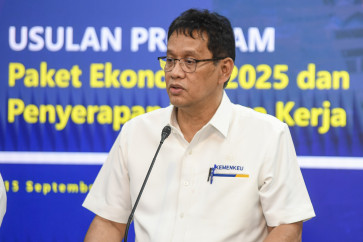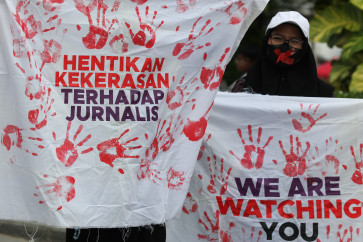Popular Reads
Top Results
Can't find what you're looking for?
View all search resultsPopular Reads
Top Results
Can't find what you're looking for?
View all search resultsMilitary transformation: Dynamics of rotational motion?
Marching orders: Troops parade after the establishment of the Board of Central and Outer Islands Fighting Groups in the wake of the Declaration of Independence on Aug
Change text size
Gift Premium Articles
to Anyone
M
arching orders: Troops parade after the establishment of the Board of Central and Outer Islands Fighting Groups in the wake of the Declaration of Independence on Aug. 17, 1945.(Courtesy of 50 Tahun Indonesia Merdeka/File)
Academic studies, followed by the military’s own internal reviews that have called for the country to have its military command structure expanded as a consequence of regional expansion — which has seen the creation of eight new provinces and hundreds of regencies and cities in the wake of the 1998 reformasi — and also in reference to global security threats and challenges, have been met with a calm response as the progress for command structure expansion has apparently been at a standstill.
In view of both domestic needs and global threats and challenges, there have reportedly been plans to establish six joint area defense commands (Kogabwilhan) throughout the country.
The plan, which was raised in 2008 under the leadership of President Joko “Jokowi” Widodo’s predecessor, Susilo Bambang Yudhoyono, would integrate the regional resources of the Army, Navy and Air Force into multiservice groups that would be positioned at certain defense flashpoints integral to preserving the country’s territorial integrity and sovereignty.
Each Kogabwilhan group will be equipped with its own fleet of warships, jet fighter squadrons and Army units. Each group’s commander, a three-star general, would be given the authority to respond without having to go through red tape at the Indonesian Military (TNI) headquarters in Jakarta.
While the idea of establishing Kogabwilhan has been left hanging in the balance, national media has been dominated by fresh reports of hundreds of high- and medium-ranking jobless TNI officers, leaving the TNI headquarters and policymakers temporarily in limbo.
An apparent solution to the personnel-related problem was among others revealed by Defense Minister Ryamizard Ryacudu, who told the media after meeting President Jokowi earlier in mid-January that it would include certainty on the establishment of Kogabwilhans, a feat that would see the opening of dozens more positions for medium- and high-ranking officers. Meanwhile, TNI commander Air Chief Marshal Hadi Tjahjanto had proposed placing those officers at civilian government posts.
At the end of January, President Jokowi acted further by announcing that he had agreed on a restructuring program for the TNI that would see 60 positions available for high-ranking officers of one-, two- and three-star generals. The President announced the decision at the opening of the TNI-Police national leadership meeting in Jakarta.
Apart from the controversy, issues related to the establishment of Kogabwilhans and the planned placement of medium- and high-ranking military officers at civilian government posts are valid evidence of the law of rotational motion.
As an illustration, let’s look back on the history of our military institution, the TNI, which came into shape in the wake of the country’s fight to maintain its independence following its declaration on Aug. 17, 1945.
Indonesia’s military began as the People’s Security Agency (BKR), which was established on Aug. 29, 1945. The agency was created more as a civilian defense force than a pure army.
However, it was during the period of BKR that a separate naval unit was established besides the army.
Ride on: Members of the People’s Security Army (TKR), a new name for the former People’s Security Agency (BKR) ride on a truck during a military ceremony held in the early years of Indonesian independence. The BKR and then the TKR were the pioneering organizations of the current Indonesian Military (TNI).(Courtesy of 50 Tahun Indonesia Merdeka/File)A more militarized institution, the People’s Security Army (TKR), was established on Oct. 5, 1945 to replace the BKR in response to an attempt to reestablish the colonial state of the Dutch East Indies (the country’s name prior to gaining independence).
The TKR was created to formalize, unite and organize the splintered units of independent troopers across Indonesia in the fight against the Dutch and allied troops.
Efforts to professionalize the Indonesian armed troops continued with the establishment of the Indonesian Republic Army (TRI) in January 1946 as a replacement for the TKR. It was during the period of the TRI that a separate air force unit was established.
Over a year later, the TRI became the TNI to create a more professional Army, with more military engagement targeted for its troops. The TNI was essentially a merger between the TRI and independent paramilitary people’s struggle organizations across the young republic.
The TNI was named the Indonesian Federal State’s Army (APRIS) in December 1949, following the naming of Indonesia as a federal state. In August 1950, it was named the Indonesian Army (APRI), as the country’s official status was brought back to that of a republic.
One major development, however, was in 1962 during the presidency of Sukarno as the military institution was named the Indonesian Armed Forces (ABRI), which integrated the TNI (which includes the three military branches: the Army, Navy and Air Force) and the National Police into one umbrella organization.
It was during the presidencies of Sukarno and his successor Soeharto that expansion of military structure was introduced, with regional defense and command structures in all three branches established across the country.
It was also during their presidencies that active officers also sat in various executive, legislative and judicial posts, under the dwifungsi (dual role) policy, besides those serving in the military, essentially making the military the most powerful institution in the country.
A crucial policy, however, was made in 1985 when then-Army chief of staff Gen. Rudini downsized the number of regional military command (Kodam) from 17 to 10 in the name of efficiency and professionalism. The liquidation of a number of Kodam automatically led to a reduced number of active military personnel in military posts.
However, it turned out not to be a problem as the government could channel them at those executive, legislative and judicial posts through an exit strategy, thanks to dwifungsi.
The fall of Soeharto in 1998 and the introduction of internal reforms in the TNI in 1999 led to the revival of a number of Kodam, with 15 Kodam nationwide today.
In view of greater domestic and international security challenges, it has been considered that the country is in dire need of an integrated security and defense command system, such as Kogabwilhan.
In line with the problem of jobless medium- and high-ranking officers, the same old problems apparently arise. Is the current demand for military transformation, or restructuring in different terms, indeed evidence of the natural impact of rotational motion? We have yet to find out.











